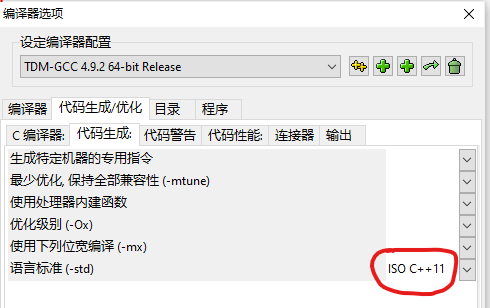反转字符串:algorithm中的reverse函数
#include <iostream>
#include <string>
#include <algorithm>
using namespace std;
int main()
{
string s= "hello";
reverse(s.begin(),s.end());
cout<<s<<endl;
return 0;
}
C++中stirng大小比较
compare()函数
类 basic_string 的成员函数 compare() 的原型如下:
int compare (const basic_string& s) const; int compare (const Ch* p) const; int compare (size_type pos, size_type n, const basic_string& s) const; int compare (size_type pos, size_type n, const basic_string& s,size_type pos2, size_type n2) const; int compare (size_type pos, size_type n, const Ch* p, size_type = npos) const;
如果在使用 compare() 函数时,参数中出现了位置和大小,比较时只能用指定的子串。例如:
s.compare {pos,n, s2);
若参与比较的两个串值相同,则函数返回 0;
若字符串 S 按字典顺序要先于 S2,则返回负值;
反之,则返回正值。
下面举例说明如何使用 string 类的 compare() 函数。
#include <iostream>
#include <string>
using namespace std;
int main ()
{
string A ("aBcdef");
string B ("AbcdEf");
string C ("123456");
string D ("123dfg");
//下面是各种比较方法
int m=A.compare (B); //完整的A和B的比较
int n=A.compare(1,5,B,4,2); //"Bcdef"和"AbcdEf"比较
int p=A.compare(1,5,B,4,2); //"Bcdef"和"Ef"比较
int q=C.compare(0,3,D,0,3); //"123"和"123"比较
cout << "m = " << m << ", n = " << n <<", p = " << p << ", q = " << q << endl;
cin.get();
return 0;
}
程序的执行结果为:
m = 1, n = -1, p = -1, q = 0
比较运算符
String 类的常见运算符包括 >、<、==、>=、<=、!=。其意义分别为"大于"、"小于"、"等于"、"大于等于"、"小于等于"、"不等于"。
举例说明:
#include <iostream>
#include <string>
using namespace std;
void TrueOrFalse (int x)
{
cout << (x?"True":"False")<<endl;
}
int main ()
{
string S1 = "DEF";
string CP1 = "ABC";
string CP2 = "DEF";
string CP3 = "DEFG";
string CP4 ="def";
cout << "S1= " << S1 << endl;
cout << "CP1 = " << CP1 <<endl;
cout << "CP2 = " << CP2 <<endl;
cout << "CP3 = " << CP3 <<endl;
cout << "CP4 = " << CP4 <<endl;
cout << "S1 <= CP1 returned ";
TrueOrFalse (S1 <=CP1);
cout << "S1 <= CP2 returned ";
TrueOrFalse (S1 <= CP2);
cout << "S1 <= CP3 returned ";
TrueOrFalse (S1 <= CP3);
cout << "CP1 <= S1 returned ";
TrueOrFalse (CP1 <= S1);
cout << "CP2 <= S1 returned ";
TrueOrFalse (CP2 <= S1);
cout << "CP4 <= S1 returned ";
TrueOrFalse (CP4 <= S1);
cin.get();
return 0;
}
程序运行结果为:
S1= DEF CP1 = ABC CP2 = DEF CP3 = DEFG CP4 = def S1 <= CP1 returned False S1 <= CP2 returned True S1 <= CP3 returned True CP1 <= S1 returned True CP2 <= S1 returned True CP4 <= S1 returned False
在使用时比较运算符时,对于参加比较的两个字符串,任一个字符串均不能为 NULL,否则程序会异常退出。
C++ string中的find()函数
1.string中find()返回值是字母在母串中的位置(下标记录),如果没有找到,那么会返回一个特别的标记npos
2. s.find_first_of(flag) ,s.find_last_of(flag) :返回子串出现在母串中的首次出现的位置,和最后一次出现的位置
3.s.find("b",5):查找某一给定位置后的子串的位置
4. while((position=s.find(flag,position))!=string::npos) :查找所有子串在母串中出现的位置
5. s.rfind (flag):反向查找子串在母串中出现的位置
#include<string.h> string str=to_string(n);
如果Dev C++运行时报错“ to_string' was not declared in this scope ”

